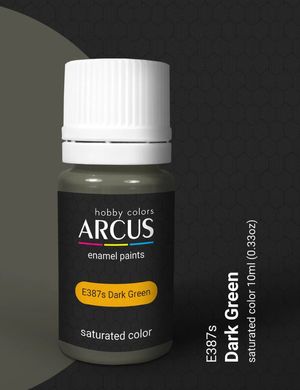Enamel paint Dark Green (Dark green) ARCUS 387 Dark green color guide MAPS:
-Dark green MAP was introduced in 1938 as a camouflage color for Royal Air Force land-based aircraft. This scheme, called Temperate Earth, also involved the use of dark earth to paint the upper surfaces. -The lower sides of the planes according to this scheme were initially painted in night and white, and in 1940 received a new color of sky (or its equivalent).
-In August 1941, the Temperate Lands Scheme was replaced by a new Day Fighter Scheme for Air Force Day Fighters. This scheme involved the use of dark green and ocean gray camouflage instead of medium sea gray.
-MAP Dark Green was also used in tropical camouflage schemes for Royal Air Force aircraft at the start of World War II. In 1939-1940, tropical camouflage involved the use of dark green and light earth colors for the upper surfaces of the aircraft, while the underside was painted sky or sky blue. Dark Green was replaced by Middle Stone in December and then in July 1941 AMO A.513/41 mistakenly reverted to tropical camouflage again. However, it was eventually replaced by the Dark Earth soon after.
-Dark Green along with Dark Earth was used for WW2 day and night bombers during WW2. The lower surfaces were painted in Sky or Night colors, respectively.
-World War II Royal Air Force night fighters wore dark green camouflage patches over the overall Medium Sea Gray paint scheme, which appeared lighter than Ocean Gray in standard fighter camouflage. In addition to this, the offending aircraft usually had special night-time underbody painting. This scheme lasted until 1951.
British aircraft in Temperate Land or Day Fighter camouflage supplied to the USSR on Lend-Lease usually retained their original colours, including dark green camouflage patches on the upper surfaces. Roundels on the upper surfaces were usually repainted AMT-4 or A-24m in green.
-Lend-Lease American-made aircraft were usually painted in the USA directly at aircraft factories. They were painted the US equivalent of MAP Dark Green - first DuPont 71-013 and then ANA 613 Olive Drab.
-Dark Green was also supplied to Romania before the start of World War II. It was used in the standard camouflage of Romanian aircraft between 1938 and 1942. This camouflage involved the use of dark green and dark earth colors instead of sky blue.
- Dark green found its use in Air Force aircraft camouflage after World War II. Redesignated BS 641, Dark Green, along with BS 638 Dark Sea Gray was used to camouflage Air Force day and night fighters from 1951-1965. The lower surfaces were painted in High-Speed Silver or BS 637 Medium Sea Gray respectively.
-The 1951-1965 overseas scheme also proposed the use of standard BS 641 Dark Green and BS 638 Dark Sea Gray for the upper surfaces of the aircraft, while the lower surfaces were to be painted BS 636 PRU Blue.
In 1965, the new camouflage was adopted by the tactical aircraft of the Royal Air Force. This scheme continued to use BS 638 Dark Sea Gray in addition to Dark Green, which was renamed BS 241 Dark Green. The lower part of the aircraft also received a new BS 627 Light Aircraft Gray paint scheme.
-RAF bombers reverted to grey-green camouflage in 1964. This camouflage was to use BS 641 Dark Green and BS 637 Medium Sea Gray for the upper surfaces of the bombers. Initially, the lower surfaces were painted Anti-Flash White, then in 1970 they changed to BS 627 Light Aircraft Gray, and in 1980 RAF bombers received dark green and medium sea gray camouflage (including the lower surfaces of the aircraft). ). This scheme was discontinued in 1984 with the retirement of the Avro Vulcan aircraft, the last Royal Air Force V-bombers


















